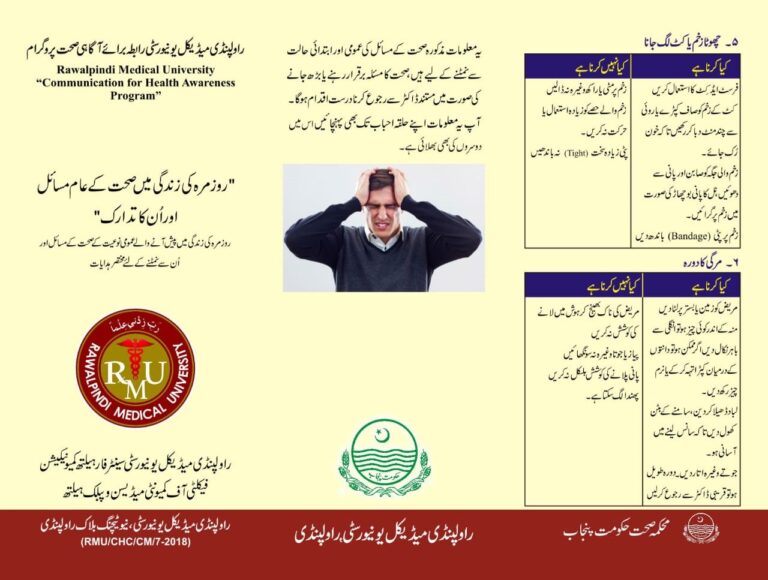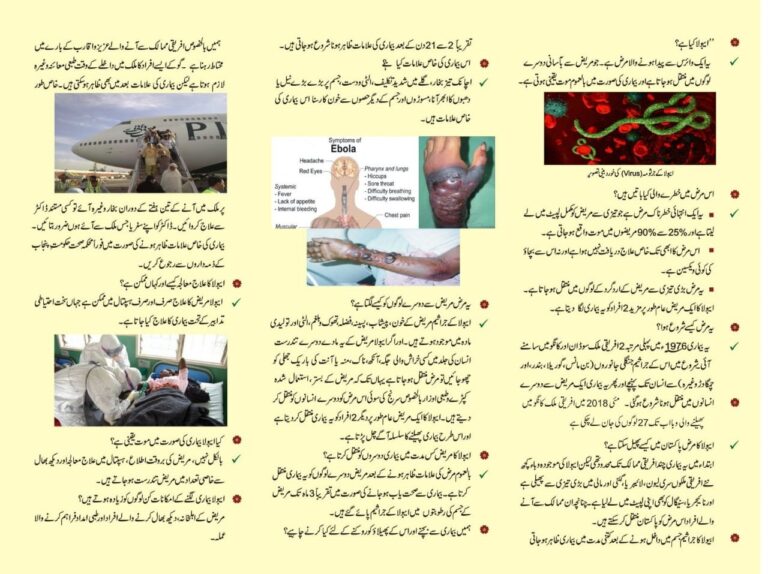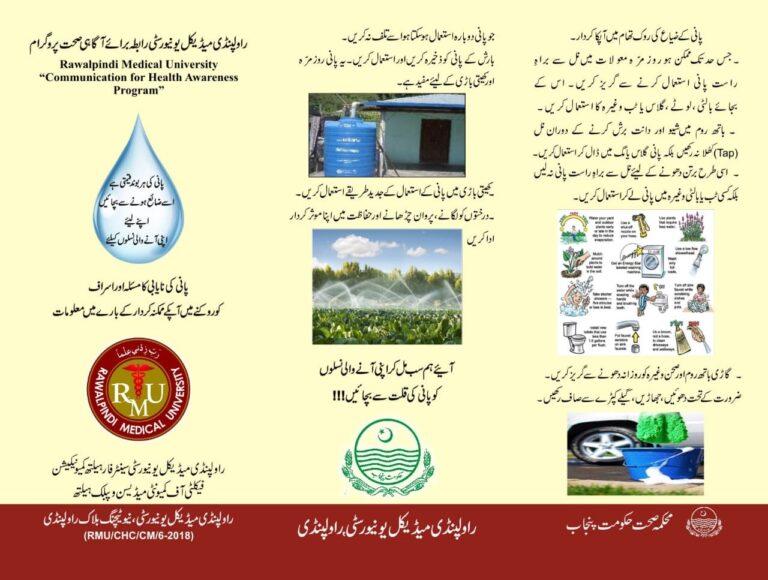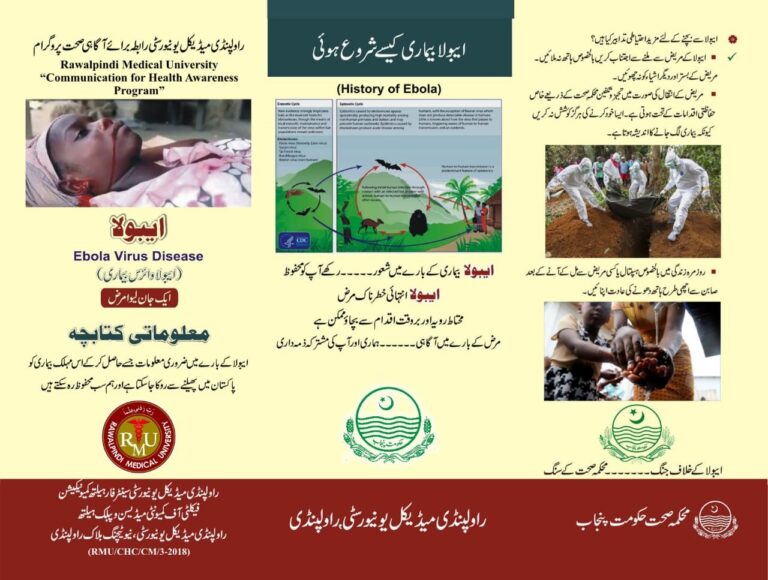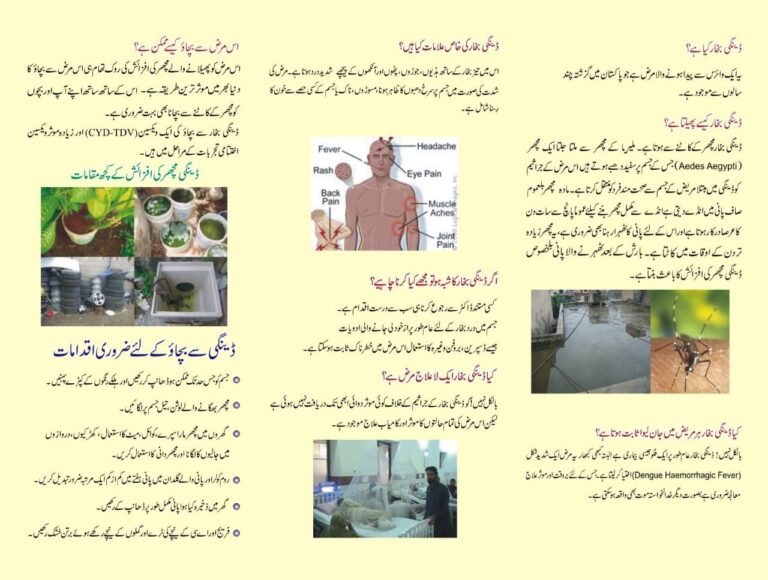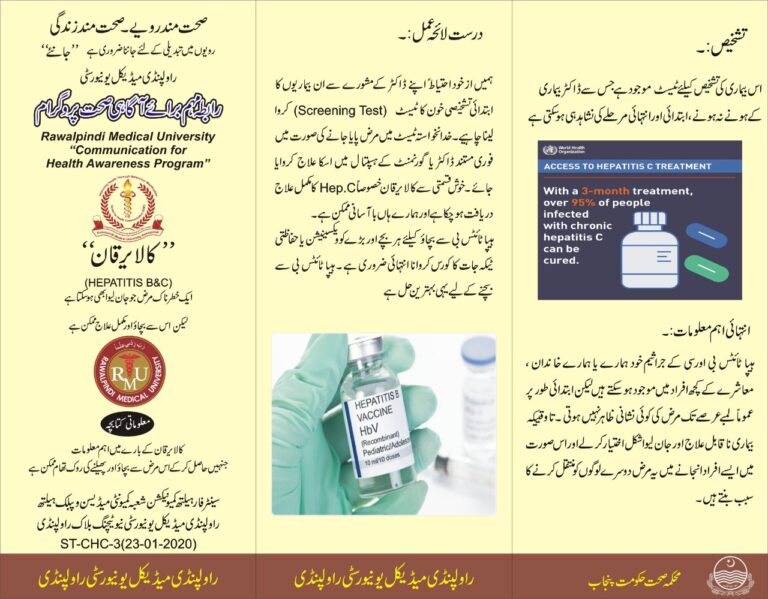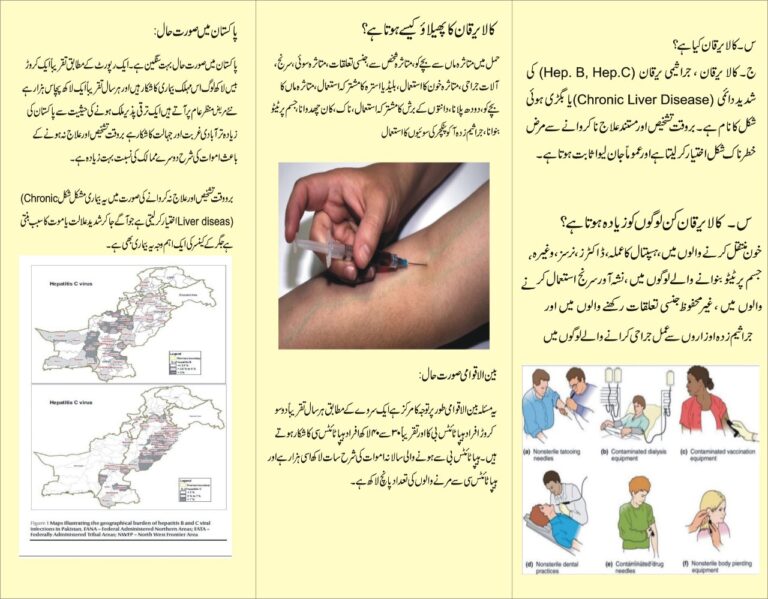Center for Health Communication (CHC)
Dr. Syed Arshad Sabir
Vision & Mission
Health message development to dissemination: under concept of “0ne-hundrad community touch-points”-project. (100CTP-Project)
Note from the desk of Vice Chancellor

Working for better health of the people who are apparently normal and are at homes is itself a great challenge for healthcare professionals. It needs one’s high intellect, professionalism and exceptional endeavor for the purpose. This program has a great cause of human service beyond responsibility. Rawalpindi Medical University Community health transformation program (CHTP) is delivering a multidisciplinary effort under umbrella of department of Community Medicine & public health. This model is trying to set new trend in practice of public health in teaching medical institutions and hence would play an effective role in health development of people of Pakistan after its country wide extrapolation in future.
INTRODUCTION
The RMU Community health transformation program (CHTI) comprises three inter-related work circles
This is community outreach component of RMU Community Health Development initiative. It aims to improve the health status of people of a selected community in close vicinity of the University (a union council) primarily through communication for desired behavior change in matters of health at individual & communal level. Other than community based training of the future doctors it is determined to employ all workable public health interventions to promote people’s health within means of university. Its agenda is to transform the targeted community in a time frame into a community which would be healthier & performing better in matters of health than before. It is a community based Program to integrate the university high intellect including faculty, PGTs, students and other relevant resources within the community for health uplift of the people. The selected community will serve as a site for community learning as well as of community serving.
This aims to promote “health literacy” in the population of the region through all possible channels. Its mission is to improve health through information & education. This program has been initiated since August 2018. The people are accessed through high school students, teachers (preferably of govt. schools) and other community groups. Peoples are communicated on health issue of immediate relevance. Health education material is home-grown & tailored to community needs (developed in CHC RMU). Its strategy is to inform & educate people inscientifically identified areas of health needs in local community context. It is empowering peoples with knowledge needed to modify their attitudes and behaviors in matters of their individual and communal health. It is to remove barriers of ignorance to good health. It is to abandon risky behaviors and exposures to reduce preventable disease and death. It is a highly doable program and has been initiated without adding any financial burden to the university.
CHC is more a concept than a physical place. This is an institution based workstation in the department of community medicine & public health, NTB RMU. It serves as work place for planning & homework for first and second initiatives other than training of undergraduates, PGTs & community health workers in health communication, coordinating center, development of community need based IEC material & other tools for public health work. It also works as office of “Public Health Advisory” generation board and “Outbreak investigation cell”. CHC serves as base of CHTP and RMU-Communication for Health Awareness Program.
A commitment of Rawalpindi Medical University Rawalpindi with health development of the people of the region.

Health is fundamental to quality & quantity of human life but mostly it is attended after it is impaired. Common man in our society understands health in terms of freedom from apparent illness and demands health in term of free medicines & treatment facilities (felt health needs). But as a medical fact, health is beyond “no illness” concept and that it is a state of complete physical, mental & social wellbeing, and not merely the absence of disease or infirmity. Disease prevention and health promotion are the real approaches to decrease human sufferings and improve wellbeing of the people. Health education aimed at inducing health generating and health promoting attitudes and behaviors is time tested and most cost-effective approach to uplift the health status of the people.
According to US Department of Health and Human Services Report about half of deaths in USA could be attributed to a limited number of largely preventable behaviors and exposures (5). Health scene of our nation reflects that diseases are very frequent across all ages & gender groups, in all sections of the community, and at the same time majority of our population is ignorant to their preventive and promotive health needs. Health statistics of the population rank it below many countries of the region. Recently Pakistan is reported to be highest in new borne mortality in the region (6). As a matter of fact despite great expansions in preventive medical knowledge & technologies, the people are not being benefited at large. Their capacity in protecting & promoting health has not been prioritized for effective interventions. Most budgetary provisions made by the Govt. in health sector go to curative sector without impacting real health solutions of the population. War against people’s health adversities cannot be fought by the traditional health means alone. Albert Einstein said “the solutions of the problems we are facing today cannot be found by the same level of thinking which have created these problems”. We have to think and act different, and better. People may not know their actual health needs but the health scientist. University is place of highest medical wisdom in the area and has liability to serve health needs of people on more scientific & innovative way.
People’s health issues cannot be adequately solved by the health sector without active involvement of the individuals and communities whose health is at stake. Health promotion demands coordinated efforts from all sectors of the society and the people are central to it. Universally, the people have been admitted as the most powerful resource in protecting, maintaining and promoting their health. Earlier
the people were considered as just a target for preventive and therapeutic services. Current trend is to demedicalize the health and involve the people in meaningful ways. This implies active involvement of the families and the communities in matters of health. People should take charge of their own health. It is a scientific fact that people’s health cannot be improved unless the factors which determine their health are improved. Though biologic, economic and environmental conditions are fundamental to health but in the face of resource scarcity, attitude & behavioral aspects of our people towards health have big space for change and would produce immediate benefits if addressed adequately. There is a big list of areas which carry great potential for behavior change & health development.
Practice of modern medicine has become a joint venture of many groups both from medical to non medical settings extending from physicians, nurses, paramedics to community health workers. People’s core abilities itself are an effective & immediate resource to their own health and health of the peoples around. Formal literacy standards should not bar to their involvement in health development process. Use of multidisciplinary public health approach, involvement of all stakeholders of community health and employing community real health needs based interventions is the philosophy behind this (CHTP) initiative.
Following are some ambitious but workable strategies to address three burning public health issues of the community.
- Self-medication and Non-qualified Healthcare practices or Quackery:

- In USA, more than 20 groups of drugs are allowed for over the counter sale including pain killers, antihistamine and H-2 receptors blockers etc. It reveals that healthcare is not possible to deliver in tight boundaries of medicine even in affluent countries. We have different population which has its own limitations and potentials.
- Self-medication or medications taken on advice of non-qualified persons (Quacks) or healthcare obtained from non-qualified sources are very frequent happenings in our society. Measures taken against such malpractices have not proven effective. Primarily it is people’s faith & acceptance for such malpractices for reasons like low literacy and low paying capacity.
- An effective intervention would be behavior change communication for both groups. It is the time to regulate this phenomenon. We have to develop our own model under our health issues, our population profile and the resources available. In fact such non-qualified sources exist very deeply and frequently. Factually, quacks or other non-qualified healthcare sources also serve as first level of contact for a big proportion of our population in times when medical care is warranted. They are the readily available & easily accessible (socially, geographically & economically) healthcare sources to the people. While addressing this issue at one end, people need to be informed & educated against hazards of such practices’. on many aspects including allowing them limited use of self care medicinal measures, also hazards of using nonqualified medical services. At the other end, non-qualified persons may also be involved purposively. It is purposed that persons who meet certain standards like trained dispensers, nurses, mid-wives, technicians, and in relatively younger age group etc) may after imparting some relevant & purposively designed education & training as to restrict them to do something and to not do other things, (e.g. to whom to medicate / treat and to whom not, or timely refer ), would play role in addressing medical-care needs of such population which is currently being not served by qualified healthcare resource in govt. or private capacity. This would also bring such health outlets or persons on tax network and health department record hence would be easy to regulate & monitor. They would also be connected to govt. sector referral mechanism. Being first contact level for majority of peoples with high potential of disease development & spread their role in earlier identification of emerging health problems or outbreaks can be well appreciated. Such data would also be very rich for health research purposes.
- It is suggested that such non-qualified HCPs who meet certain criteria like age <45Y, 12grade science education, have some certified training and agreed for new role etc would be subjected to education & training focusing on following areas;
- hazards of non-qualified healthcare practices
- Hazards of un-safe injection practices
- Hazards of unjustified use of drugs , antibiotics etc
- Value of timely referral of patients
- Management of common health problems like ARI, Diarrhea, Fever and minor injury etc.
- First aid trainings like CPR, wound first aid, seizure care etc.
- Role in disease surveillance
- Standardization of Qualified Healthcare Practices (GP clinics)
- It is on Govt. agenda to regulate private health sector. This program will focus ethical and academic aspects of medical care practices. After purposively involvement of Private HCPs of the area they will be subjected to medical care improvement areas including standardization of clinical facility & practice, continuous medical education (CME), reporting health data, population control, disease surveillance and medical research etc.
- Population Control Strategy in CHTP:
- Rapid population growth is a significant national issue and major bar to national development. The issue has not been addressed effectively in spite of historical efforts. The strategy adopted in CHTP is as under;
- Healthcare providers (HCPs) of the UC will be taken on board ( DHA will be made instrumental)
- Nikah registrar of the UC will be bound to motivate, inform and guide (on paper) to each new bridegroom to see specified HCP of the UC. The area Counselor will be intermediary.
- The HCP will hold counseling session with bridegroom or couple on family planning including contraception on pre-decided guidelines. (this work of HCP & Nikah registrar may be hired on payment if DHA & MOP agrees) . Output of this male education & motivation would be measureable.
- Rapid population growth is a significant national issue and major bar to national development. The issue has not been addressed effectively in spite of historical efforts. The strategy adopted in CHTP is as under;
- University (CHC) FM Radio channel
Our idea of community preventive care while working within community is not a newer one but CHTP is comprehensive and a measureable initiative. Such concepts have been practiced in developed world like “Healthy people-2010” in United States. While such projects are part of many renowned health institutions of the country including AGA KHAN University, Baqai Medical University Karachi and of ShifaTameer-e-Millat University Islamabad etc. This initiative is taken by department of community medicine & public health but it is proposed for joint efforts of all the relevant departments of the university. Its spirit is missionary, beyond official liability. Work outline of RMU CHTP is projected by
work-matrix.
It is also visualized that after the laid down objectives of CHTP for a give area (Union council l) are achieved (5years) we would move to next community (UC) of the region to benefit other population of the region. After the first success this program may be proposed to be replicated by each Govt. Medical and Private Medical College in its relevant community around hence the mission of total community health transformation would be achieved.

"VISION-RMU"
|
Community involvement
|
Partnership for Health
|
Resource Partners
|
|---|---|---|
|
Political Leadership
|
Educational Institutions of the Area Govt Private
|
Department of Community
|
|
Social Workers / Community Groups
|
NGOs in the Area Community Groups
|
Gynae & Obstetrics RMU 2. Healthcare delivery
|
|
Professional Groupsin the Area like Barbers-, Food-sellers-, hotels-,Medical Stores Unionsoffice etc in the Area.. Trade Unions or
|
2. Municipal Corporation
|
NGOs in the area
|
|
Target community
|
Who will deliver
|
Priority work
|
Who will do
|
|---|---|---|---|
|
Potential groups like
|
Community
|
Community
|
Faculty of CM & PH
|
|
School teachers & senior students
|
Medical students surveys
|
Environmental
|
Health education
|
|
Health risk professions health risk
|
Health
|
Healthcare
|
Trained
|






